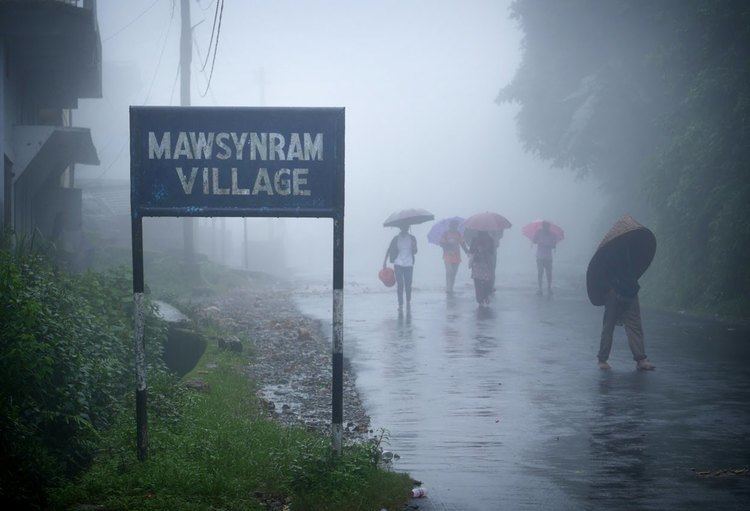Time zone IST (UTC+5:30) Elevation 2,000 m Local time Thursday 12:44 AM | Talukas Mawsynram C.D. Block PIN 793113 Area 2,788 km² Area code 03673 | |
 | ||
Weather 12°C, Wind N at 3 km/h, 81% Humidity University Mawsynram Border Area College | ||
Mawsynram (/ˈmɔːsɪnˌrʌm/) is a village in the East Khasi Hills district of Meghalaya state in north-eastern India, 65 kilometres from Shillong. It is reportedly the wettest place on Earth, with an average annual rainfall of 11,872 millimetres (467.4 in), but that claim is disputed by Lloró, Colombia, which reported an average yearly rainfall of 12,717 millimetres (500.7 in) between 1952 and 1989 and López de Micay, also in Colombia, which reported 12,892 mm (507.6 in) per year between 1960 and 2012. According to the Guinness Book of World Records, Mawsynram received 26,000 millimetres (1,000 in) of rainfall in 1985.
Contents
- Map of Mawsynram Meghalaya 793113
- Entspannungsmusik f r hochsensible a trip to mawsynram meghalaya india
- Location
- Climate and rainfall
- Natural landmarks
- References
Map of Mawsynram, Meghalaya 793113
Entspannungsmusik f r hochsensible a trip to mawsynram meghalaya india
Location
Mawsynram is located at 25° 18′ N, 91° 35′ E, at an altitude of about 1,400 metres (4,600 ft), 16 km west of Cherrapunji, in the Khasi Hills in the state of Meghalaya (India) . The name of the village contains Maw, a Khasi word meaning stone, and thus might refer to certain megaliths in the surrounding area. Khasi Hills are rich with such megaliths.
Climate and rainfall
Under the Köppen climate classification, Mawsynram features a subtropical highland climate with an extraordinarily showery and long monsoonal season and a short dry season. Based on the data of a recent few decades, it appears to be the wettest place in the world, or the place with the highest average annual rainfall. Mawsynram receives nearly 10,000 millimeters of rain in an average year, and the vast majority of rain it falls during the monsoon months. A comparison of rainfalls for Cherrapunji and Mawsynram for some years is given in Table 1.
Primarily due to the high altitude, it seldom gets truly hot in Mawsynram. Average monthly temperatures range from around 11°C in January to just above 20°C in August. The village also experiences a brief but noticeably drier season from December until February, when monthly precipitation on average does not exceed 30 millimetres (1.2 in). The little precipitation during the village’s “low sun” season is something that is shared by many areas with this type of climate.
Table 1: Comparison of rainfalls for Cherrapunji and Mawsynram from 1970.
Three reasons can be cited for high rainfall at Mawsynram:
- The warm moist winds of the northward-moving air from the Bay of Bengal during the monsoon, which cover an extensive area but are forced to converge into the narrower zone over the Khasi Hills, thus concentrating their moisture.
- The alignment of the Khasi Hills (east to west) places them directly in the path of the airflow from the Bay of Bengal, producing a significant uplift (plus cooling, further condensation and thus more rain).
- Finally, uplift over the Khasi Hills is virtually continuous in the monsoon period because the lifted air is constantly being pulled up by vigorous winds in the upper atmosphere, hence the rainfall is more or less continuous.
Natural landmarks
Located in Mawsynram, is a cave named Mawjymbuin, known for its stalagmites. Inside this cave is a pair of notable speleothems - breast-shaped stalactite over a massive stalagmite. The area is known for its many caves, commercialised and non-commercialised, which contain remnants of a past that tells us of the history of the plateau that was once under water.
